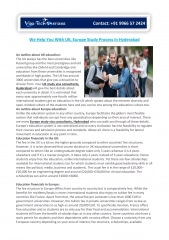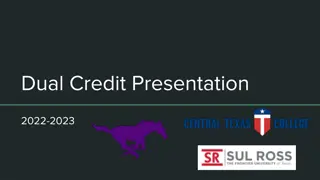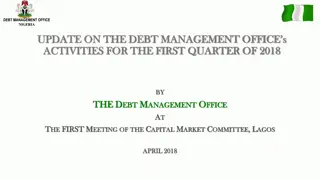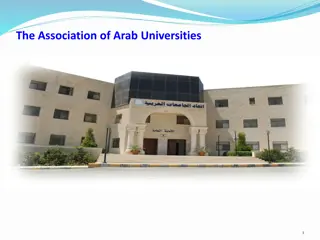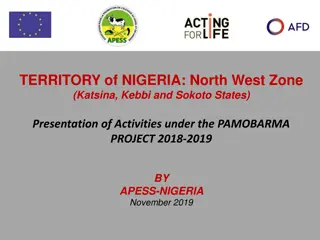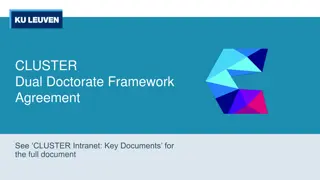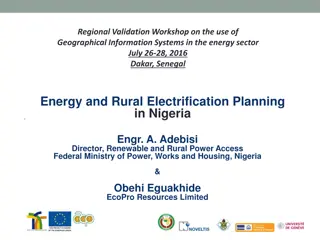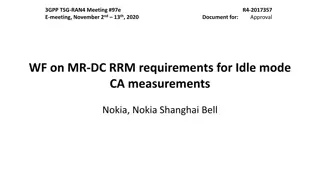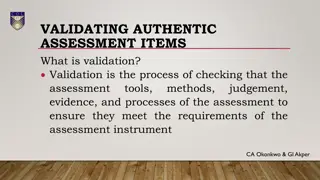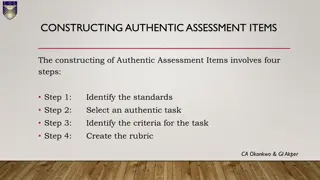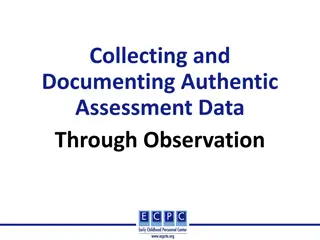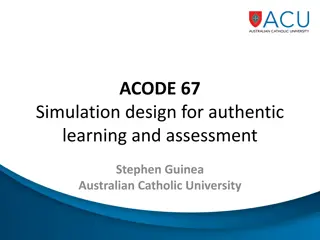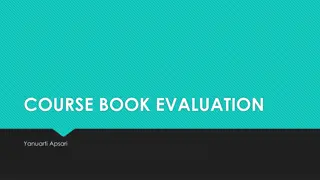Models of Authentic Assessment in Dual-Mode Universities in Nigeria
Three categories of Models of Authentic Assessment relevant to dual-mode universities in Nigeria include Observation, Performance Sample, and Actual Performance. The Observation model involves assessing students based on performance and attitude, the Performance Sample model evaluates tangible results submitted by students, and the Actual Performance model tests students' abilities in specific activities. Various tools like the Developmental Checklist are used to aid in observation assessments. Effective observation guidelines and examples of individual developmental checklists are also provided.
Download Presentation

Please find below an Image/Link to download the presentation.
The content on the website is provided AS IS for your information and personal use only. It may not be sold, licensed, or shared on other websites without obtaining consent from the author. Download presentation by click this link. If you encounter any issues during the download, it is possible that the publisher has removed the file from their server.
E N D
Presentation Transcript
MODELS OF AUTHENTIC ASSESSMENT RELEVANT TO DUAL-MODE UNIVERSITIES IN NIGERIA There are three categories of Models of Authentic Assessment namely: 1. Observation 2. Performance Sample 3. Actual Performance CA Okonkwo & GI Akper
THE OBSERVATION MODEL This model is used by teachers and educators to assess their students by observing the performance and the attitude of students during and after class. To identify the weaknesses and strengthens of the students from the observation records. CA Okonkwo & GI Akper
EFFECTIVE OBSERVATION GUIDELINES Observe not only one but all the students. Observation must be frequent and regular. Observation must be recorded in writing. Observation should cover both routine and exceptional occurrences. Reliability of observation records is enhanced if multiple observations are gathered and synthesized. (Hart,1994) CA Okonkwo & GI Akper
THE PERFORMANCE SAMPLE MODEL This model involves tangible results that demonstrates students achievements. In this model the teacher or educator assesses the students performance or the product. The teacher requires the students to submit their portfolios after a period of time say the semester or a year. The teacher rates the student/s performance sample submitted in the form of a portfolio. based on actual CA Okonkwo & GI Akper
THE ACTUAL PERFORMANCE MODEL This authentic assessment model is used to test and measure students performance at a specific place and time. The teacher can assess the students by conducting actual performance such as singing, dancing, teaching or staging a drama/acting etc. Can also be used by the teacher to determine the behavior of the student during the performance. CA Okonkwo & GI Akper
TOOLS USED IN OBSERVATION MODEL (1) Developmental Checklist this is an observation tool which requires the teacher recorder to describe the traits or learning behaviors being assessed. CA Okonkwo & GI Akper
EXAMPLE OF INDIVIDUAL DEVELOPMENTAL CHECKLIST: CHECKLIST TEACHER: ..DATE: .. Expectation Teacher has positive expectation for all students. Teacher greets students at the door to welcome them to class. Beginning of class is located Rating Comments Other factors traits to be observed CA Okonkwo & GI Akper
EXAMPLE OF GROUP DEVELOPMENTAL RECORD SHEET Example of Group Recording Sheet Success Criterion 1 2 Recorder Initial judgment- level/standard Success Criterion Success Criterion 3 Success Criterion 4 Final judgment level/standard Teacher A Teacher B Teacher C Teacher D CA Okonkwo & GI Akper
EXAMPLE OF OBSERVATION CHECKLIST: LEADERSHIP CHECKLIST STUDENT NAME: 1 2 3 Total Observation dates 1 Asks for help from team members. 2 Asks for competing points of view. 3 Asks for opinions from non-participating team members. 4 Gives praise and/or encouragement CA Okonkwo & GI Akper
TOOLS USED IN OBSERVATION MODEL (2) Interview Record Sheet - another observation tool which is also called the Conference recording form. consists of a list of questions the teacher intends to ask and space for recording the student s answers. CA Okonkwo & GI Akper
EXAMPLE OF INTERVIEW RECORD SHEET PROGRAMME: ------------------------------------------------------------ NAME OF INTERVIEWEE: . DATE: ---------------------- INTERVIEWER: INSTRUCTIONS TO INTERVIEWERS: .. Communication Skill Writing Skill Other Traits CA Okonkwo & GI Akper
TOOLS USED FOR PERFORMANCE SAMPLE MODEL Actual performance sample are submitted in the form of Portfolios. A portfolio is a compilation of pieces of evidence of individual s skills, ideas, interests and accomplishments and can be used by the teacher to assess the growth and development of the students at various levels. What can be included in a portfolio? Essay, Video tapes, Audio tapes, Conference notes, Pictures, Graphics/Charts, Art works, Group reports, Compact disk, Field reports, and so on. CA Okonkwo & GI Akper
ACTUAL PERFORMANCE ASSESSMENT TOOLS (I) Performance Checklist Consists of a list of behavior that make up a certain type of performance. Used to determine whether or not an individual behaves in a certain way (usually desired) when asked to complete a particular task. Oral Questioning This is an appropriate assessment method for actual performance when the objectives are: o To assess the student s stock of knowledge and/or o To determine the student s ability to communicate ideas in coherent verbal sentences CA Okonkwo & GI Akper
ACTUAL PERFORMANCE ASSESSMENT TOOLS (II) Self-Assessment Checklist This may consist of an overview of the subject matter in the form of a checklist. It could be a list of several characteristics or activities present in a subject for a study. The students may be encouraged to refer to the checklist as desired to monitor their own learning. CA Okonkwo & GI Akper
EXAMPLE OF SELF-ASSESSMENT CHECKLIST (1) STUDENT SELF-ASSESSMENT CHECKLIST SUBJECT TITLE: _________________________________ Intended Learning Outcome S/No I can I think I can I cannot 1 Distinguish science. Demonstrate ecosystem. Read a mercury thermometer currently. between true and false 2 knowledge of different 3 . . 10 Other items from the area of the content as desired. CA Okonkwo & GI Akper
EXAMPLE OF SELF-ASSESSMENT CHECKLIST (II) The numbered column facilitates discussion of the checklist. The second column can be populated with the intended learning outcomes for the course which can be taken directly from the syllabus. CA Okonkwo & GI Akper
ACTUAL PERFORMANCE ASSESSMENT TOOLS (III) Observation and Self Report Could be used by the teacher to record the frequency of student behavior, activities or remarks. The teacher may use tally sheet as device to record the frequency of occurrence. CA Okonkwo & GI Akper
GROUP ACTIVITY 2 1. Consider the assessment practices we are already employing in dual-mode and single mode universities in Nigeria and classify them into the three models a. Observations b. Performance Samples c. Actual Performance The template for the classification is presented in the next slide. CA Okonkwo & GI Akper
TEMPLATE FOR GROUP ACTIVITY 2 S/No Activity Models of Authentic Assessment Observation Performance Sample Comment Actual Performance Seminars Projects Dissertations Thesis SIWES Practicums Field Trips Micro Teaching Teaching Practice 1 2 3 4 5 6 7 8 9 10 Mention Others CA Okonkwo & GI Akper
GROUP ACTIVITY 2 CONT. 2. Which of these three models do you consider as NOT being relevant to dual-mode universities in Nigeria? 3. Which of these three models are we not adequately utilizing in our institutions and how can we improve? CA Okonkwo & GI Akper
AUTHENTIC ASSESSMENT TOOLS USEFUL TO DUAL-MODE UNIVERSITIES IN NIGERIA (I) The three categories of authentic assessment models are relevant to dual-mode universities for the following reasons: They increase learners engagement with the learning process when the tasks are well designed and aligned to the learners disciplines and course requirements. CA Okonkwo & GI Akper
AUTHENTIC ASSESSMENT TOOLS USEFUL TO DUAL-MODE UNIVERSITIES IN NIGERIA (II) They set the stage for learners to develop higher order cognitive skills that align with both learners and employers assessment is the heart of the learning experience. expectations noting that The assessment practices enable learners to bring their whole selves to engage with meaningful, relevant tasks to prepare them for a life of 21st century work and lifelong learning. CA Okonkwo & GI Akper
AUTHENTIC ASSESSMENT TOOLS USEFUL TO DUAL-MODE UNIVERSITIES IN NIGERIA (III) As said earlier, these models assess higher order thinking beyond remembering. They bring about novel or new situations or examples that has not been used in the classroom into the assessment process. recall and CA Okonkwo & GI Akper
AUTHENTIC ASSESSMENT TOOLS USEFUL TO DUAL-MODE UNIVERSITIES IN NIGERIA (IV) They can be used to make assessments to contribute to values beyond the school. The three models are based on students abilities to perform meaningful tasks they may have to do in the real world. Useful tools are those that can be used to achieve the desired outcome. CA Okonkwo & GI Akper
ASSIGNMENT 1: OTHER AA TOOLS TO CLASSIFY Observations Essays Interviews Performance Tasks Exhibitions and Demonstrations Portfolios Teacher Created Tests Journals Written Assessment Performance Tasks Projects Character Analysis Students Debates (Individual or Group) Drawing or Writing about a Book or a Chapter of a Book Experiments trial and error learning Journal Entries (Reflective Writing) Student Self- Assessments Peer Assessment and Evaluation Presentations Tier Learning Classrooms Graphic organizers Conducting Research and Writing Reports Discussion Partners or Groups The list goes on CA Okonkwo & GI Akper
FOLLOW-UP QUESTIONS TO ASSIGNMENT 1 1. Classify the tools in assignment 1 into the three Authentic Assessment Models 2. Identity the tools that are useful for dual-mode universities in Nigeria and give reasons to support your perception. 3. Identify the tools that are NOT useful for dual-mode universities in Nigeria and give reasons for your perception. 4. Discuss your thoughts with your colleagues from the same discipline to critique and come-up with the discipline group final thoughts and submit tomorrow for review. CA Okonkwo & GI Akper
APPRECIATION Thank you CA Okonkwo & GI Akper



